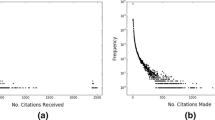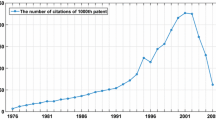Abstract
This paper quantitatively analyzes how technology has evolved within the technological field of computer graphic processing systems. A path-dependent technological development path is called a ‘technological trajectory’ in the field of Innovation Economics. The technological trajectory of a technological field can be mapped as the main paths of patent citation networks. Using a method called main path analysis, main paths are calculated from the whole patent citation network data of the technological field. This paper examines how technology has evolved within the technological field of computer graphic processing systems using main path analysis. In addition, the change of the main paths over time is analyzed. According to this analysis, the appearances and disappearances of nodes on the main paths show certain patterns. First, all nodes observed on the main paths three times consecutively at 5-year intervals did not drop out from the main paths in the long term. Second, most of the appearances and disappearances of the nodes occur toward the end of the main paths. These observations are consistent with the technological lock-in process. The result of this research suggests that it takes less than 10 years to determine which technologies are locked-in. In addition, various patterns of the appearances and disappearances of companies owning patents on the main paths are also observed. Three companies are taken as examples to illustrate these patterns. These observations provide insight into how knowledge networks are formed.












Similar content being viewed by others
References
Dosi, G. (1982). Technological paradigms and technological trajectories: a suggested interpretation of the determinants and directions of technical change. Research Policy, 11(3), 147–162.
Verspagen, B. (2007). Mapping technological trajectories as patent citation networks: a study on the history of fuel cell research. Advances in Complex Systems, 10(1), 93–115.
Hummon, N. P., & Doreian, P. (1989). Connectivity in a citation network: the development of DNA theory. Social Networks, 11(1), 39–63.
Possas, M. L., Salles-Filho, S., & da Silveira, J. M. (1996). An evolutionary approach to technological innovation in agriculture: some preliminary remarks. Research Policy, 25(6), 933–945.
Vincenti, W. G. (1995). The retractable airplane landing gear-response. Technology and Culture, 36(2), 453–454.
Fontana, R., Nuvolari, A., & Verspagen, B. (2009). Mapping technological trajectories as patent citation networks. An application to data communication standards. Economics of Innovation and New Technology, 18(4), 311–336.
Martinelli, A. (2012). An emerging paradigm or just another trajectory? Understanding the nature of technological changes using engineering heuristics in the telecommunications switching industry. Research Policy, 41(2), 414–429.
Barberá-Tomás, D., Jiménez-Sáez, F., & Castelló-Molina, I. (2011). Mapping the importance of the real world: the validity of connectivity analysis of patent citations networks. Research Policy, 40(3), 473–486.
Huenteler, J., Schmidt, T. S., Ossenbrink, J., & Hoffmann, V. H. (2016). Technology life-cycles in the energy sector—technological characteristics and the role of deployment for innovation. Technological Forecasting & Social Change, 104, 102–121.
Abernathy, W. J., & Utterback, J. M. (1978). Patterns of industrial innovation. Technology Review, 80(7), 40–47.
Davies, A., & Hobday, M. (2005). The business of projects: managing innovation in complex products and systems. Cambridge: Cambridge University Press.
Yu, D., & Sheng, L. (2020). Knowledge diffusion paths of blockchain domain: the main path analysis. Scientometrics, 125(1), 471–497.
Xiao, Yu., Lu, L. Y. Y., Liu, J. S., & Zhou, Z. (2014). Knowledge diffusion path analysis of data quality literature: a main path analysis. Journal of Informetrics, 8(3), 594–605.
Barbieri, N., Ghisetti, C., Gilli, M., Marin, G., & Nicolli, F. (2016). A survey of the literature on environmental innovation based on main path analysis: a survey of the literature on environmental innovation. Journal of Economic Surveys, 30(3), 596–623.
Liang, H., Wang, J.-J., Xue, Y., & Cui, X. (2016). IT outsourcing research from 1992 to 2013: a literature review based on main path analysis. Information & Management, 53(2), 227–251.
Jung, H., & Lee, B. G. (2020). Research trends in text mining: semantic network and main path analysis of selected journals. Expert Systems with Applications, 162, 113851.
Liu, J. S., Lu, L. Y. Y., Wen-Min, Lu., & Lin, B. J. Y. (2013). Data envelopment analysis 1978–2010: a citation-based literature survey. Omega (Oxford), 41(1), 3–15.
Yan, J., Tseng, F.-M., & Lu, L. Y. Y. (2018). Developmental trajectories of new energy vehicle research in economic management: main path analysis. Technological Forecasting & Social Change, 137, 168–181.
Hung, S.-C., Liu, J. S., Lu, L. Y. Y., & Tseng, Y.-C. (2014). Technological change in lithium iron phosphate battery: the key-route main path analysis. Scientometrics, 100(1), 97–120.
Fu, H., Wang, M., Li, P., Jiang, S., Wei, Hu., Guo, X., & Cao, M. (2019). Tracing knowledge development trajectories of the internet of things domain: a main path analysis. IEEE Transactions on Industrial Informatics, 15(12), 6531–6540.
Liu, J. S., & Lu, L. Y. Y. (2012). An integrated approach for main path analysis: development of the Hirsch index as an example. Journal of the American Society for Information Science and Technology, 63(3), 528–542.
de Nooy, W., Mrvar, A., & Batagelj, V. (2018). Exploratory Social Network Analysis with Pajek. Rev. and expand (3rd ed.). Cambridge: Cambridge University Press.
Liu, J. S., & Kuan, C.-H. (2016). A new approach for main path analysis: decay in knowledge diffusion. Journal of the Association for Information Science and Technology, 67(2), 465–476.
Nelson, R. R., & Winter, S. G. (1982). An Evolutionary Theory of Economic Change. Cambridge: Belknap Press of Harvard University Press.
Arthur, W. B. (1989). Competing technologies, increasing returns, and lock-in by historical events. The Economic Journal, 99(394), 116–131.
David, P. A. (1985). Clio and the economics of QWERTY. The American Economic Review, 75(2), 332–337.
Dranove, D., & Gandal, N. (2003). The Dvd-vs.-Divx standard war: empirical evidence of network effects and preannouncement effects. Journal of Economics & Management Strategy, 12(3), 363–386.
Koski, H., & Kretschmer, T. (2005). Entry, standards and competition: firm strategies and the diffusion of mobile telephony. Review of Industrial Organization, 26(1), 89–113.
McClanahan Chris. (2011). History and evolution of GPU architecture: a paper survey. https://api.semanticscholar.org/CorpusID:2337358. Accessed 16 Jan 2021.
Singer, Graham. (2019). The History of the Modern Graphics Processor. Techspot. https://www.techspot.com/article/650-history-of-the-gpu/. Accessed 16 Jan 2021.
Peddie, Jon. (2019). Famous Graphics Chips: IBM’s Professional Graphics, the PGC and 8514/A. IEEE Computer Society Tech News. https://www.computer.org/publications/tech-news/chasing-pixels/Famous-Graphics-Chips-IBMs-professional-graphics-the-PGC-and-8514A. Accessed 16 Jan 2021.
Acknowledgements
The authors benefited from comments by and discussion with Professor Hideyuki Tanaka and Project Assistant Professor Yuya Shibuya of the Interfaculty Initiative in Information Studies, The University of Tokyo.
Author information
Authors and Affiliations
Corresponding author
Additional information
Publisher's Note
Springer Nature remains neutral with regard to jurisdictional claims in published maps and institutional affiliations.
Rights and permissions
About this article
Cite this article
Watanabe, I., Takagi, S. Technological Trajectory Analysis of Patent Citation Networks: Examining the Technological Evolution of Computer Graphic Processing Systems. Rev Socionetwork Strat 15, 1–25 (2021). https://doi.org/10.1007/s12626-020-00066-1
Received:
Accepted:
Published:
Issue Date:
DOI: https://doi.org/10.1007/s12626-020-00066-1




